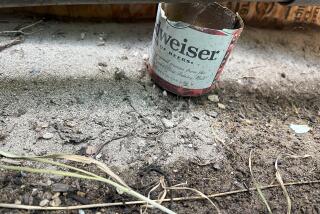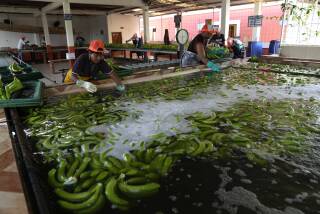Meese Tours Peru Coca Area, Calls Problem ‘Overpowering’
- Share via
UPPER HUALLAGA VALLEY, Peru — Minutes after landing here Sunday after a 90-minute helicopter flight over thousands of acres of coca plants in the world’s most prolific cocaine-producing region, Atty. Gen. Edwin Meese III called the problem “overpowering” and said it must be attacked by aerial herbicides.
The stark assessment by the usually optimistic Meese pointed up the severity of the cocaine crisis, despite accelerated Administration efforts to deal with it.
Meese said that in addition to replacing manual eradication with aerial spraying, which he estimated is about a year away, the effort must be combined with crop substitution, interdiction of smugglers and greater efforts to cut drug demand in the United States and elsewhere.
Meese, wearing a khaki safari suit and a Drug Enforcement Administration cap, described his impression in his fourth stop on a weeklong, five-country South American mission designed to bolster anti-cocaine programs.
Accompanied on the helicopter tour by Jose Barsallo, Peru’s interior minister, who has led his country’s outgunned efforts against coca-growing and -smuggling, Meese said he was struck by both the enormity and openness of the coca-growing.
As three helicopters carrying Meese and his party swooped low over hillside areas that had been cleared of trees and replaced with coca, freshly harvested leaves could clearly be seen drying on pads in front of crude structures.
A herbicide to be used against the coca plant is now being tested and could be available “within a year,” Meese said.
In 1987, Peruvian authorities, under attack by terrorist organizations in the Huallaga Valley, managed to eradicate manually only about 850 acres of coca plants--out of a total of more than 200,000 acres under cultivation.
Even with an effective herbicide, Meese said, programs of economic development and crop substitution would be needed to provide transitional support for those Peruvians indigenous to the valley who have turned to growing coca because of its substantial profitability.
While the United States expects to increase assistance to Peru for coca eradication, Meese said help must also come from a U.N. program, because European nations now are experiencing cocaine problems along with the United States. He put no price tag on such a program.
DEA administrator John C. Lawn, who is accompanying Meese, observed that the Reagan Administration has been working for seven years on the drug problem after “years of inertia.”
“We have a long way to go before we turn this problem around,” Lawn said.
Francis A. Keating II, assistant Treasury secretary for enforcement and another member of the Meese mission, sounded a note that the attorney general has been hearing often in his discussions of the cocaine crisis with South American officials.
Noting that Peruvians make their living by raising coca in response to foreign demand for the drug, Keating observed: “If we wanted tomatoes, they would grow tomatoes. If we wanted cantaloupes, they would grow cantaloupes. It’s just too bad that what we want is dope.”
More to Read
Sign up for Essential California
The most important California stories and recommendations in your inbox every morning.
You may occasionally receive promotional content from the Los Angeles Times.













